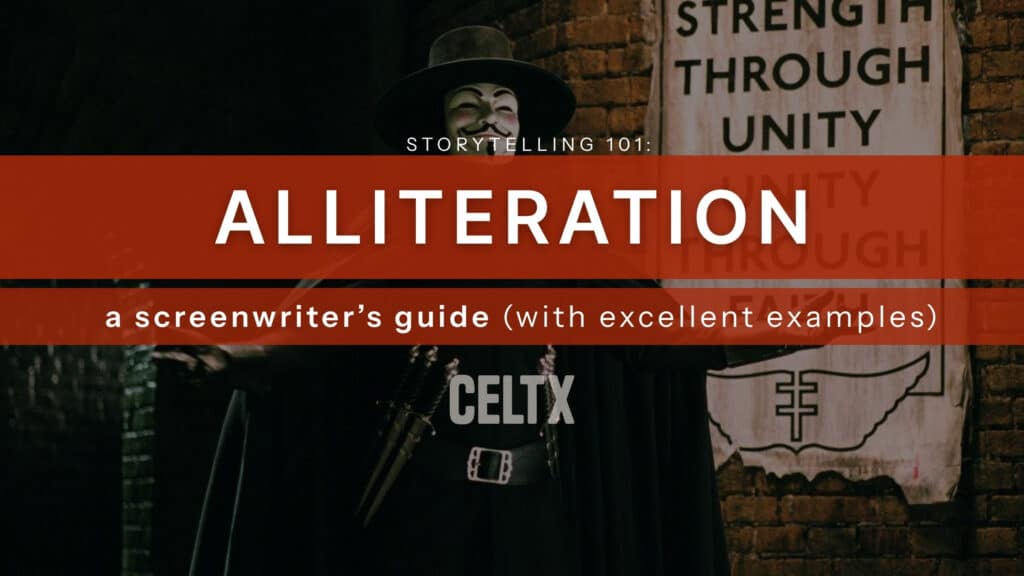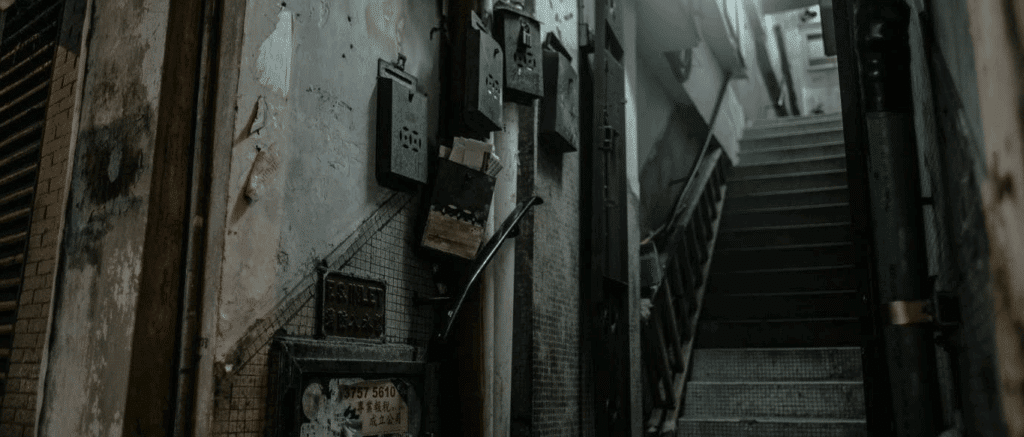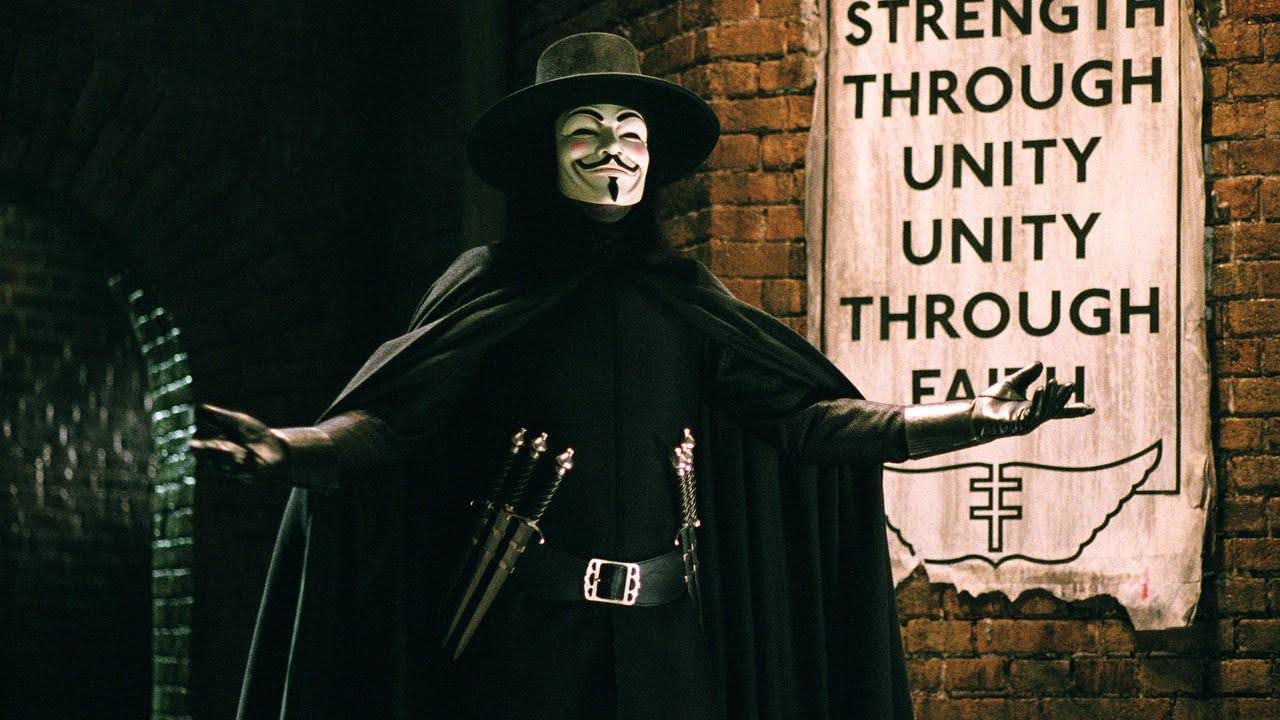
When you think of the most memorable lines, character names, or sharpest snippets of dialogue and film and TV, chances are there’s something happening under the surface. Not just clever meaning or emotional punch. It’s something rhythmic and feels good in the mouth when spoken and satisfying to hear. That ‘something’ is often alliteration.
Alliteration can elevate your script without the audience ever realizing why they remember. But like any stylistic device, alliteration needs to be used intentionally and not slathered across every line.
In today’s blog we’ll break down what alliteration is, why it works, where to use it, and how to avoid turning your script into a tongue twister.
Let’s go…
Table of Contents
- What is Alliteration?
- Screenwriting Applications of Alliteration
- Examples in Film & TV
- When to Use Alliteration (and When to Stop)
- FAQs
- Conclusion
What is Alliteration?
The Poetry Foundation describes alliteration as:
The repetition of initial stressed, consonant sounds in a series of words within a phrase or verse line. Alliteration need not reuse all initial consonants; “pizza” and “place” alliterate.
Examples:
- Peter Parker
- Mickey Mouse
- Dunkin’ Donuts
- Fight for freedom
It doesn’t matter how the words are spelled but the shared sound. It produces musicality, memorability, emphasis and verbal ‘snap’. And in screenwriting, where rhythm and readability matter, this is a gift.

Screenwriting Applications of Alliteration
So, how can alliteration be applied in screenwriting? Let’s take a look at some ways you can use it to elevate your work:
1. Character Naming
Believe it or not, comic books figured out the marketing magic of alliteration decades ago. Many superheroes, both DC and Marvel, have alliterative names:
- Lois Lane
- Clark Kent
- Bruce Banner
- Peter Parker
- Wade Wilson
- J. Jonah Jameson
So, why is alliteration used? Well, because it rolls off the tongue more smoothly, makes it easier to remember, it’s more distinct, and marketable.
And even outside superhero worlds, alliteration is a popular literary device when it comes to naming characters. Think Don Draper (Mad Men), Hannah Horvath (Girls), and Fred Flinstone.

But remember, it’s not all about the name. A character needs to live up to the name you give them, with a well-rounded and relatable personality. For tips on how to create great characters, click here.
2. Dialogue Rhythm
Film dialogue is spoken, which means it needs to sound good out loud. Words that share sounds naturally link, creating rhythmic emphasis. Examples include:
- “We don’t get to choose what we are, only what we become.”
- “Big bad bosses break before breakfast.”
- “Say something smart, slick, and simple.”
A little alliteration gives dialogue punch, playfulness, confidence, and most of all, memorability.
The trick is not to force it though. Characters should speak naturally. A detective might use sharp, clipped alliteration. A blunt action hero would probably use less.
And for more on writing killer dialogue in your next screenplay, click here.
3. Action Line Flair
Action lines may make up a huge chunk of your script, but they don’t have to be boring. The rhythm of your prose is part of the tone.
Let’s compare:
The wind blows through the alley.
To:
Wind whips through the wet alleyway.
The second line has texture, sound and atmosphere, heightening the mood of the scene. However, don’t confuse this with writing a novel. Your action lines still need to be clear with rhythm layered behind it.

Examples in Film & TV
Now, let’s take a look at some iconic uses of alliteration in film and TV.
V for Vendetta (2005)
The famous V-monologue is practically an alliteration symphony. While it’s intentionally theatrical, it demonstrates how sound repetition can build momentum:
“Voilà! In view, a humble vaudevillian veteran…”
The repetition of v isn’t accidental. It shapes tone: grandiose, poetic, defiant.
Spider-Man (Various Films and Comics)
Peter Parker is an easy example, but notice how supporting characters get the treatment too:
- Green Goblin
- Daily Jungle
- J. Jonah Jameson
The repetition gives the universe an internal musical coherence. It’s branding through sound.
Breaking Bad (2008-2013)
No overt superhero names here, yet Walter White. The repeated w in Walter White lends softness and ordinariness before the character evolves. The sound fits the character and story.
Harry Potter (Film Series 2001-2011)
JK Rowling intentionally used alliteration for characters tied to whimsy, magic, history, philosophy, and menace:
- Severus Snape (sharp, slithering s)
- Luna Lovegood (soft and dreamy)
- Godric Gryffindor
- Nearly Headless Nick
The sounds here are all rhythmic, and a little surreal which are perfect for the magical universe they’re a part of.

The Simpsons (1989-Present)
For comedy, alliteration can accelerate humor. For example:
- Millhouse Mussolini Van Houten
- Seymour Skinner
- Krusty the Clown
Bart’s prank calls to Moe also often rely on sound repetition for comedic timing.
When to Use Alliteration (and When to Stop)
Alliteration is most effective when it serves the story, tone, or character, not the writer’s ego. Think of it as the seasoning you sprinkle, not the sauce you drown the dish in. Used thoughtfully, it enhances rhythm, mood, and memorability. Used carelessly, it becomes a distraction.
Use Alliteration When:
1. You Want to Make a Name Instantly Memorable
Names are mini brain-hooks. A lightly alliterative name tends to “stick,” especially in genres where characters need to stand out quickly such as in superhero films, ensemble stories, animation, satire, or heightened dramas.
Alliteration helps the audience remember and recall your character which is crucial in a first-time read.
2. You Want Dialogue to Pop or Punch
A line meant to land whether as a threat, joke, rallying statement, or emotional beat, gains extra impact when the sounds align.
While sharp, clipped consonants inject energy, soft consonants lend warmth. Alliteration subtly guides emotion through sound.
Aaron Sorkin is one of the film and TV industry’s expert dialogue writers. He’s known for his almost ‘musical’ dialogue, which is explored in more detail in Jason Hellerman’s article for No Film School: 3 Ways Aaron Sorkin Writes ‘Musical’ Dialogue.
3. You Want the Audience to Feel the Mood
In action lines, alliteration can shape atmosphere:
- Harsh consonants (k, t, g) can create tension or aggression.
- Gentle consonants (l, m, s) can add softness, sadness, or intimacy.
This works particularly well when describing weather, environment, motion, or transitions.

4. You’re Establishing Tone or Genre
Comedic, stylized, poetic, or heightened worlds welcome more sonic play. Gritty realism typically wants less.
Alliteration can signal the rules of the world without stating them.
Avoid Alliteration When:
1. The Reader Can Tell You’re Doing It
If it starts to look like clever wordplay for cleverness’ sake, it breaks the illusion. The audience should feel the effect, not notice the technique.
2. It Forces You to Twist Sentences Unnaturally
If you’re bending a line simply to maintain the alliteration, the meaning is no longer leading the language. Meaning must always lead.
3. It Doesn’t Match the Character’s Voice
A grizzled truck driver likely won’t speak with poetic consonant coordination. A charismatic cult leader might. Match sound to persona.
4. It Slows a Scene That Should Move Quickly
Overly ornate dialogue can drag pacing. High-action scenes need clarity and speed, and too much alliteration can gum up the urgency.
A general rule of thumb is if the script feels smarter or sharper because of the alliteration, keep it. If it feels written, cut it.
FAQs
Alliteration repeats consonant sounds at the beginning of words. Assonance repeats vowel sounds inside words.
Example:
Alliteration: “Silver sun slowly sank.”
Assonance: “The early bird.”
The V-monologue in V for Vendetta is the most famous deliberate example.
Yes, but only if it matches the character’s personality, emotional state, and context. Smartass characters use it more than stoic ones. So, use alliteration in this way sparingly.
Yes. Alliteration increases rhythmic momentum. Use sharp sounds (k, t, p) for speed, and softer sounds (m, l, s) for slower or emotional pacing.
Conclusion
Great screenwriting isn’t just about what characters say, it’s about how the words sound when spoken aloud. Film is an auditory experience as much as a visual one, and the rhythms you create on the page shape how your story feels in motion. Alliteration may seem like a small tool in the writer’s kit, but it has an outsized ability to make dialogue memorable, sharpen emotional beats, and give action lines texture and flow. The ear is always listening, even when the audience isn’t consciously analyzing every turn of phrase.
When used intentionally, alliteration works almost invisibly. A character name lingers. A line becomes quotable. A moment hits harder than expected. The audience can’t always explain why: they just remember. And in screenwriting, memorability is currency. You’re not only telling a story; you’re crafting an experience that must live inside someone’s mind long after the credits roll.

But the key is subtlety. Alliteration shouldn’t call attention to itself. It shouldn’t feel clever for cleverness’ sake. It should feel natural to the world, voice, and moment. When in doubt, favor clarity and emotional truth, then refine with rhythm. Think of alliteration not as decoration, but as design. A shaping force. A way to make language do more with less.
Ultimately, your script is a performance waiting to happen. You control pacing, sound, cadence, and flow long before actors step onscreen. By tuning your ear to the music of language, you’ll write dialogue that actors want to say and audiences want to remember.
Ready to start crafting compelling, rhythmic dialogue? Start for free today.
Up Next:

10 Tips for Writing Dialogue That Feels Real
Take your writing further by learning how to craft dialogue that flows naturally, reveals character, and keeps readers engaged — without leaning on gimmicks or overused techniques.
